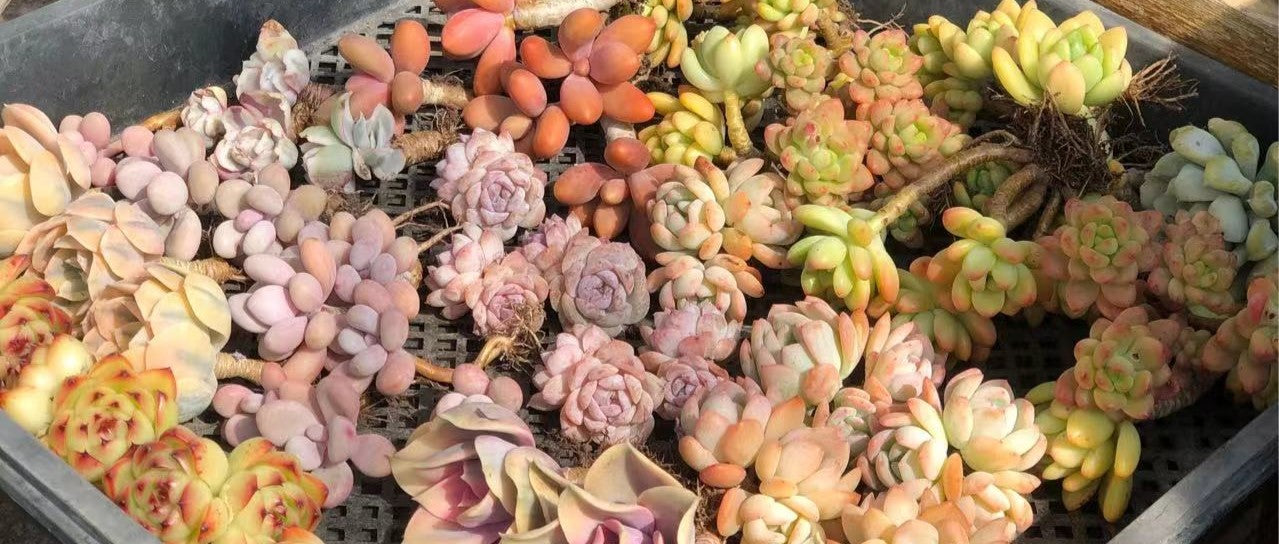A Beginner's Guide to Growing Succulents from the Crassulaceae Family

This article serves as a beginner's guide to planting succulent plants in the Crassulaceae family. It covers common planting issues, and after reading this article, you should have a general idea of how to take care of succulent plants in the Crassulaceae family.

Succulent plants from the Crassulaceae family are known for their rich colours, diverse forms, and charming appearance. Most varieties are extremely easy to care for, making them ideal for beginners and enthusiasts. When considering purchasing succulent plants, it is advisable to choose reasonably priced beginner varieties. Even if they accidentally endure rain, sun exposure, or minor damage, you won't feel too saddened if the succulents fail to survive.
For the most frequent question, people ask why the leaves at the base of succulent plants tend to fall off even with proper care. There are also inquiries about why some succulent plants in other people's homes look so beautiful and have mature stems. The answer to both questions can be summed up in one explanation: mature stems develop as plants continuously grow, with the lower leaves gradually withering and dropping off over time, representing the accumulation of years grown.

When it comes to planting succulent plants, the most suitable seasons for most varieties in the Crassulaceae family are spring, autumn, and winter. Summer can be relatively challenging, so for beginners, it's advisable to avoid planting during this hot season. The ideal time is during the refreshing autumn or winter seasons. However, note that for plants in the Crassula genus, it is not recommended to plant them in late spring or early summer. It is not recommended to mix cacti or plants from the Rosaceae family (such as Lithops or Adenium) together for planting.
After receiving your plants, it's important to inspect their health. If you notice any signs of rot or decay, it's crucial to remove the affected leaves or stems, allows the wound to dry thoroughly, and then proceed with planting.
After Acquiring Your Crassulaceae Plants: The Next Steps
- Root Trimming: When you get your Crassulaceae plants, it's recommended to trim the roots before planting. Generally, remove all the dry roots except for the main root. While some varieties like Jade Plants can skip this step.

- Drying roots: Typically, drying out your plant's roots for 1-3 days is sufficient before planting. However, experienced plant enthusiasts know that the safest approach is to keep the plants in a cool, well-ventilated area with the tops facing up, without planting them. After about 1-2 weeks, the Crassulaceae plants will naturally sprout roots in the air. That's when you can plant them with a near-perfect survival rate. Don't worry about them getting dehydrated or shrinking during this period—they will bounce back quickly.
- Succulent Soil: The main purpose of the soil for succulent is to prevent waterlogging and promote airflow. Typically, a combination of any stones and peat moss is sufficent, with the stones should be porous, breathable, and lightweight. Personally, I use a mixture of pumice and coconut coir in a volume ratio of 2:1. (The size of the pumice varies depending on the size of the plants, with smaller succulents typically requiring 1-3mm particles and larger succulents requiring 3-6mm particles.) A small amount of slow-release fertilizer can be added as well. After you are more experience planter, you will find that the soil is not very important; it is more important to control watering and lighting. In greenhouse envrionment, many succulents are planted directly in the ground using a mixture of peat moss with charcoal ash and perlite. Sometimes, for cost-saving purposes, they may even be planted directly in garden soil.

- Potting: To plant succulent plants, you can simply bury the roots in the planting medium, leaving the leaves above the surface. If you are working with rootless succulents, gently insert them into the soil. When potting, you can use some auxiliary tools such as a trowel or tweezers. Tweezers can be useful not only for picking up any planting medium that accidentally falls into the crevices between the succulent leaves but also for leveling the medium. Additionally, you can use the other end of the tweezers to adjust the position of the succulents already planted in the medium, making it convenient and easy to place them in the desired location.
- Hardening off: After potting, succulent plants should be placed in a shaded and well-ventilated area with diffused light to allow them to recover and establish their roots. During this period, it is important to avoid direct sunlight, prevent waterlogging, and enhance ventilation. In the spring, autumn, and winter seasons, root establishment is usually easier, and typically a period of 3-7 days is sufficient. Once the plants have rooted, they will become plump and firm. At this point, you can gradually increase the amount of light they receive until normal care and maintenance can be resumed.

- Watering: The general rule is to check the weather forecast and avoid watering on cloudy or rainy days. In sunny conditions, allow the soil to dry out completely within 3-4 days. The frequency and amount of watering depend on factors such as the soil mix, pot size, environment, and light conditions. There's no one-size-fits-all answer, so you'll need to experiment to find the right watering regimen for your plants. As a general guideline, water your plants in the evening on sunny days. Water more frequently in spring and autumn, reduce watering or even stop it in summer, and water sparingly in winter. The safest watering method is to hold off on watering until the plants show signs of dehydration or shrivelling. This approach will result in robust plants with vibrant colors.
- Light: Crassulaceae plants generally thrive in ample light. With sufficient light and appropriate watering, they will grow robust and compact, with vibrant colors. In normal household conditions, except for summer when shading is necessary, they can receive full-day sunlight during other seasons. Experienced plant enthusiasts have successfully grown summer-type Succulent Plants without shading. However, I wouldn't recommend this approach to beginners.
- Top Covering: For aesthetic purposes, you can cover the surface of the soil mix with your preferred decorative material.
Regarding outdoor cultivation:
Based on my personal planting experience in Toronto, Canada, most succulents in the Crassulaceae family can be grown outdoors, except during Canada's long winter season. Once the nighttime temperature reaches 8 degrees Celsius or above, it is suitable for outdoor cultivation, especially for common varieties and plants in the Echeveria genus. Some people may worry about the combination of summer and rainy seasons causing plant death, but it's actually not a major issue. Succulent plants grown outdoors can be planted in relatively smaller pots, using well-draining soil with coarse particles to facilitate faster moisture evaporation. It is not recommended to use large flower pots unless the potting soil has excellent water permeability and aeration. Otherwise, the plants are prone to rot, usually starting from the lower leaves.

Propagation: Crassulaceae plants can be propagated through beheading, leaf cuttings, seed sowing, and division.
- Beheading: This method is straightforward. Use a small knife to cut the plant above the root system. Afterward, allow the base to dry out and develop roots before planting. Remember to leave at least 3-5 healthy leaves on the base, as insufficient foliage may cause the base to die. After beheading, avoid watering the base for at least 1-2 weeks.
- Leaf Cuttings: Carefully select healthy, plump leaves and place them on the soil surface or partially insert them into the soil mix. Avoid direct sunlight during this period and provide partial shade if necessary. Patience is key, as you'll need to wait for the cuttings to develop into new plants.
- Seed Sowing: Sow the seeds in a well-draining soil mix and provide appropriate moisture and light conditions. This method requires patience and time for the seeds to germinate and grow into mature plants.
- Division: This method involves separating offsets or dividing clumps of Crassulaceae plants into individual plants. Make sure each divided section has roots and leaves, and plant them in appropriate soil mixes.
Remember, propagating plants requires experimentation and patience. It's important to provide suitable conditions for each propagation method and monitor the progress of the new plants.
